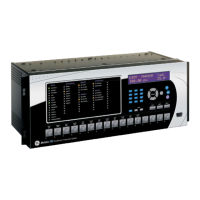
 Loading...
Loading...
Do you have a question about the GE T35 UR Series and is the answer not in the manual?
| Brand | GE |
|---|---|
| Model | T35 UR Series |
| Category | Protection Device |
| Language | English |
Guides through initial setup, including safety precautions and inspection procedures.
Provides an overview of the UR series digital relays, their architecture, and important concepts.
Details PC requirements and installation steps for the EnerVista UR Setup software.
Covers mounting, wiring, and rear terminal layout of the UR series hardware.
Explains faceplate keypad operation, menu navigation, relay activation, and passwords.
Introduces the T35 Transformer Protection System, its applications, features, and communication options.
Details the order codes for different T35 configurations, including modules and options.
Information on ordering replacement modules for UR series devices, including order codes.
Lists technical specifications for protection elements, including differential, thermal, and breaker arcing current.
Describes physical aspects of T35, including horizontal/vertical unit dimensions and panel cutout details.
Illustrates the rear terminal view and explains the module slot assignment convention.
Provides typical wiring diagrams and details for control power connections.
Overview of EnerVista UR Setup software, including its graphical interface and basic features.
Explains how to engage a device and use settings files for relay configuration.
Covers advanced features like settings templates, securing FlexLogic equations, and file traceability.
Details enhanced and standard faceplate layouts, including LED indicators, keypad, and display.
Introduces the settings menu hierarchy and provides page references for various categories.
Covers security settings, including user accounts, CyberSentry, passwords, and access supervision.
Details AC input configurations, power system settings, signal sources, and transformer parameters.
Explains FlexLogic architecture, operators, equations, and timers for customized relay logic.
Describes the use of setting groups for different operating situations and transformer differential elements.
Covers control elements such as trip buses, selector switches, digital counters, and monitoring elements.
Details contact inputs, virtual inputs, remote devices, direct I/O, and teleprotection configurations.
Explains DCmA inputs, RTD inputs, and DCmA outputs for connecting external transducers.
Covers test modes, force contact inputs/outputs, and relay self-tests for verifying functionality.
Introduces the actual values menu, including status, metering, and product information sections.
Displays the current state of contact inputs, virtual inputs, remote devices, communications, and Ethernet links.
Provides conventions for power and energy, phase angles, and symmetrical components.
Accesses user-programmable fault reports, event records, oscillography, data logger, and breaker maintenance data.
Shows model information, order codes, serial number, MAC address, and firmware revisions.
Lists commands for relay operations, including virtual inputs, clear records, and relay maintenance.
Explains target messages, priority status, and self-test error messages for diagnostics.
Covers enabling security management, adding users, and modifying user privileges.
Details CyberSentry security features, including authentication, RBAC, and remote authentication.
General procedures for testing differential restraint, minimum pickup, slope, and breakpoint parameters.
Illustrates current distribution and test procedures for Y/y0° and Yg/D30° transformers with phase faults.
Details the procedure for testing inrush inhibit using secondary injection with adjustable second harmonic component.
Explains the test procedure for overexcitation inhibit using adjustable 5th harmonic component.
Contains tables for differential restraint and inrush inhibit tests with sample data for verification.
Explains module withdrawal/insertion, safety precautions, and module compatibility with CPUs.
Instructions for replacing the real-time clock battery and proper disposal of batteries.
Covers unit decommissioning, clearing settings files, and managing COMTRADE or .csv files.
Outlines the process for returning the device to the factory for repair, including RMA and shipping.
Guidelines for storing the unit indoors in a cool, dry place and powering it up periodically.
Disposal requirements for the unit and battery, and module removal for recycling.
Lists FlexAnalog parameters with address, name, units, and description for analog inputs.
Details FlexAnalog parameters accessible via web browser or keypad, showing address and description.
Lists FlexInteger items viewable via web browser, including address, name, units, and description.
Covers Modbus RTU protocol, physical layer, data link layer, and packet format.
Explains the Modbus RTU CRC-16 algorithm for error checking and data stream processing.
Lists supported Modbus function codes and details packet transmission examples for various function codes.
Covers obtaining relay files via Modbus, COMTRADE/oscillography/data logger files, and reading oscillography files.
Provides the Modbus memory map with addresses, register names, ranges, and default values.
Introduces IEC 61850 standard, its components, and communication profiles.
Explains IEC 61850 object-oriented structure, including logical nodes and data objects.
Details reporting, file transfer, timestamps, logical device names, and location settings.
Describes GSSE and GOOSE services, fixed and configurable GOOSE, and their configurations.
Guides on creating ICD files and configuring IEC 61850 settings using EnerVista UR Setup.
Covers customizing IEC 61850 related settings like IP addresses, logical node prefixes, and GOOSE configurations.
Explains ICD file structure, including header, communication, IED sections, and DataTypeTemplates.
Procedure to create an ICD file from a T35 IED or offline settings file using EnerVista UR Setup.
Discusses SCD files generated by system configurators, including substation project creation and IED configuration.
Step-by-step guide to update the T35 with new configuration from an SCD file using EnerVista UR Setup.
Outlines ACSI basic conformance and models conformance statements for services.
Lists IEC 61850 logical nodes supported by UR-series relays, categorized by function.
Covers interoperability, network configuration, physical layer, and link layer details of IEC 60870-5-104.
Explains system or device definition, network configuration, and physical layer aspects.
Details DNP/IEC 104 point lists for binary input/MSP and analog input/MME points.
Provides DNP v3.00 Device Profile, including supported objects, functions, and data link layer parameters.
Details vendor name, device name, DNP level, supported objects, functions, and data link layer parameters.
Lists DNP binary input points and binary/control relay output points.
Configures DNP binary input points, including static object number, change event object, and request codes.
Lists DNP binary output status points and control relay output blocks, including object numbers and request codes.
Details binary and frozen counters, including object numbers, supported function codes, and variation.
Explains DNP analog input data points, deadbands, and scaling factors.
Lists major updates for T35 manual revisions, detailing page changes, descriptions, and sections.
Provides a history of manual revisions, including manual P/N, T35 revision, release date, and ECO.
Details major updates for T35 manual revisions Y4, Y3, and Y2, specifying page changes and descriptions.
Lists standard abbreviations used in the manual, covering technical terms and device components.
Outlines GE Multilin warranty terms, including duration and conditions for products shipped after Oct 2013.